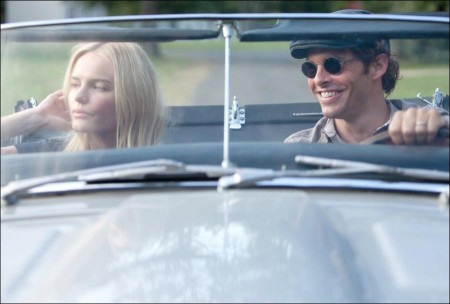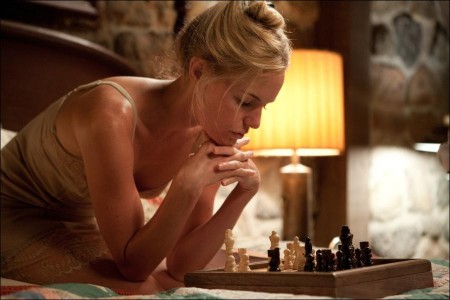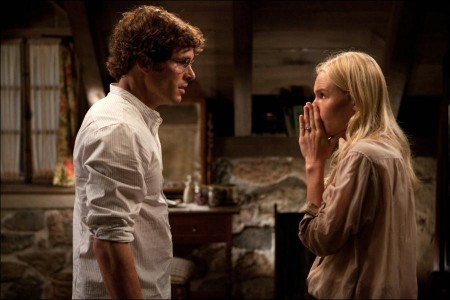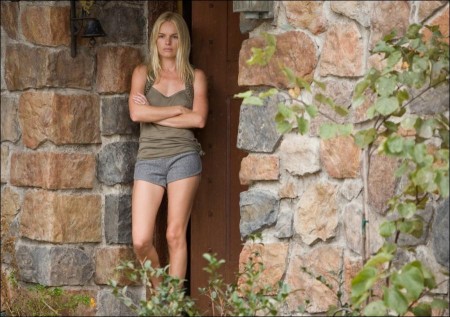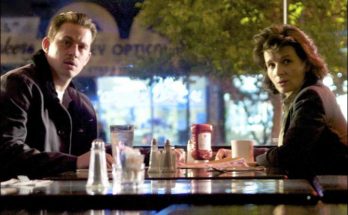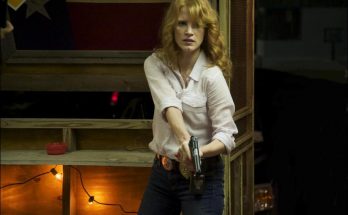Taglines: Don’t let them in.
The film is a remake of the 1971 Sam Peckinpah thriller that starred Dustin Hoffman. The original revolved around a young American and his English wife who move to rural England and face increasingly vicious local harassment.
It’s a question made terrifyingly apparent to Hollywood screenwriter David Sumner (James Marsden) and his actress wife Amy (Kate Bosworth) when they move to her small hometown in the Deep South after her father’s death. Smiling faces, warm welcomes and what were once comfortable old relationships take on a sinister tinge for David and Amy, who find themselves driven to a crisis-laden brink in Screen Gems’ frightening reimagining of the classic 1971 film “Straw Dogs.”
The suspenseful, gut-wrenching and intensely cathartic new version brings the original story to the present-day American South, and sets it against a backdrop of small town life where everyone knows too much about each other, the town hierarchy is determined by your place within the ranks of the high school football team and the performance of the football team at Friday night’s game determines the fates of many. David and Amy’s plan is to prepare for sale the family home, which has fallen into disrepair, and for David to take advantage of the quiet and solitude to complete the screenplay he’s working on.
But all is not as bucolic as it seems in Blackwater, Mississippi, and the arrival of the Sumners stirs up long-dormant resentments and suspicious actions. Once there, Amy slips back into being the hometown celebrity, which leaves David feeling out of touch with his wife and questioning her behavior. Meanwhile, tensions build in their marriage and old conflicts re-emerge with the locals, most notably with Amy’s ex-boyfriend Charlie (Alexander Skarsgård), who, along with his fellow former football teammates Bic (Drew Powell), Norman (Rhys Coiro) and Chris (Billy Lush) push the limits of David’s tolerance and the Sumners’ marriage, forcing them to re-evaluate each other and their relationship.
When the daughter of the former football coach Tom Heddon (James Woods) goes missing, her father takes the law into his own hands, enlisting Charlie and his boys to help him search for her and setting into motion a series of events that ultimately leads to an explosively violent confrontation, escalating to a shocking, catastrophic climax that will shatter the lives of everyone involved.
The 1971 release starred Dustin Hoffman and Susan George and was written and directed by Sam Peckinpah. David Zaleg Goodman also has a writing credit on the original’s screenplay and both films are based on the book, The Siege at Trencher’s Farm by Gordon Williams.
Where Machismo Rules
“Peckinpah had a very definite point of view of human beings and how they behaved,” says Lurie, of the original film’s shocking violence. “He was very much a pessimist about human beings, and I believe I’m an optimist. So I thought it might be an interesting experiment to see whether or not you can do the same story, but tell it from a different point of view.”
Working more from Gordon William’s novel, The Siege of Trencher’s Farm than from Peckinpah’s film, Lurie felt that updating the story and bringing its special psychological terror into the classic American setting of a small Southern town — where life was ruled by how the football team performed on Friday night and the townspeople’s roles were a clearly defined hierarchy — would bring a modern edge to what is at heart a powerful and ultimately terrifying examination of a relationship being incomprehensibly tested and torn apart.
Recalled Marc Frydman, Lurie’s partner at Battleplan Productions, “Rod and I had been discussing ‘Straw Dogs’ since we first started working together over 10 years ago. Then while we were under contract at ABC we realized that a subsidiary of the company that had been active in the 70’s, but had since folded, ABC Pictures, still held the option on the project. I contacted the person handling the rights and told them that the second it became available I’d have a check to them.”
Rights in hand, Lurie then set about regrounding everything in William’s novel, shifting the location to a small fictional Southern town steeped in traditions of brutality, and transforming the characters into roles within that classic American setting.
“It’s not so much that it’s the South,” explains Lurie. “What I wanted to define was a culture where violence was a part of their everyday life, where they’re hunting, where there’s football – which I adore – and where their people solve things through fights. Where machismo rules.”
Continued Frydman, ”Rod felt strongly that one of the reason’s the original film didn’t really work in the States was because it was set in England. By relocating the setting to a Southern football culture and transferring the characters to players in a small town ruled by that culture, it provided a background and familiar setting that we felt was missing from the original. Rod and I both felt that we weren’t remaking Peckinpah, we were retelling the story.”
The southern location also provided the background for the hot and sweaty atmosphere that Lurie wanted to bring to the film, and which came to life when Screen Gems’ president Clint Culpepper suggested shooting the film in Shreveport, Louisiana. “Clint knew that we wanted a heavy, intense feel for the movie and had previously shot movies there and suggested it as a perfect set-up for the shoot,” recalled Frydman. “After a scouting trip down there we knew we had found our Blackwater and other than dealing with rain issues it really was the perfect setting and provided the exact feel and look we were striving for in updating the story.”
One thing Lurie and Frydman agreed should not change, was the central core of the story’s menacing buildup, which forces a reluctant hero to use violence in order to defend his wife, his property and both of their lives – and whether after being shattered, his marriage could ever be rebuilt. But it begins with a seemingly happy union.
“This is a couple at the nascent state of their marriage, where they’re making an assumption that everything is okay,” offers Lurie, who modernized the marriage by making Amy Sumner a working woman, in this case an actress, and her husband David – a math professor in Peckinpah’s version – a Hollywood screenwriter. “They’ve probably lived their entire relationship both working and not spending that much time together. And now they’re beginning to learn the hard truths of their marriage, and it doesn’t help that they’ve come into a world where her old boyfriend also exists.” Stepping into the roles of Amy and David are two of Hollywood’s rapidly rising stars – James Marsden and Kate Bosworth.
For Marsden, who had most recently been seen on screen in much lighter roles, the script struck a chord with him. “When I read the script for the first time, I imagined the whole thing in my head. It felt like something I could contribute to,” he remembers.
Lurie knew exactly what Marsden could contribute: a performance completely different from Dustin Hoffman’s. “Instead of going for a New York Jewish intellectual, I went for a sort of Greenwich, Connecticut country club sort of intellectual, and that’s what Jimmy brought. And it was very freeing for all of us, because we were not at all beholden to anything Hoffman had ever done. He’s one of the most talented people I’ve ever met in my life.”
Bosworth also had a strong reaction after reading Lurie’s script. “I had never seen the original film and I read the script before watching it and thought it was really interesting. I’m always drawn to character relationships and the complexities that exist there and this story is rich with them.” Laughing, she adds “Then I rented the original and was immediately terrified.”
Easing that trepidation was the chance to rehearse for two weeks with Lurie before production began. “It was a great luxury to just throw out ideas and talk about the differences between the films,” recalls Marsden. “We really explored, and continued to explore while we were shooting, the dynamic between David and Amy – their marriage, the problems with their marriage, where they came from and where they’re at in their lives. Rod was really great throughout the rehearsals and the shoot with giving us the room to move around a bit and find things. We had a certain amount of creative license to find the characters ourselves and make them our own.”
Adds Bosworth, “Rod had to gain a real kind of trust with me to be able to go to certain places and be courageous with certain things and learn the extent to which I’ll go. It was that sort of creating – talking about trust, experiencing this together and knowing there is nothing too deep or far that will frighten me or take me out of the moment. I think we all had that mentality so the fear, in a way, was positive and fueled our performances. Hopefully that will show.”
Lurie says the trust went both ways with her and Bosworth. “I remember telling her, ‘Since I wrote the screenplay, I know the character better than you. But when we start shooting, you’re eventually going to know the character better than me, and I will question myself if you challenge me.’ Sure enough, a week into shooting, there was a piece of direction I had given her, and she said, ‘I think you’re wrong.’ I didn’t think I was wrong. But I trusted her, and it turned out that she was right.”
As the shoot got underway, the decision to film in Shreveport proved to be advantageous for reasons other than the inherent heat and humidity. As Marsden and Bosworth had learned when they had previously worked together on Superman, which filmed in Sydney, Australia, shooting a film at a distant location away from your everyday life immediately forges stronger connections amongst the cast. “This existence in the trenches together creates an intense bond,” says Bosworth. “We’d be out to dinner, having lunch, at a music festival and it was a constant conversation of the characters and the script and the film. It’s this inescapable existence which works so well.”
Alexander Skarsgård, cast in the role of Amy’s high school boyfriend Charlie Venner, agrees that being together on location is an absolute asset. “When you shoot in Los Angeles everyone has their families and friends close by so after a long day or on weekends you hang out with your loved ones. When you’re on location you really get to know people and it adds a lot of flavor to it – we play locals and I’ve never been to Louisiana before so it’s been great to be out here and getting a little flavor of the culture.”
Casting Skarsgård in the role of Charlie seemed an unusual choice. The son of actor Stellan Skarsgård, he grew up in Sweden and although an established actor in that country had only recently come to the attention of the American public. Recalled Frydman, “We had a long list of actors for the role and had seen Alex in “Generation Kill” as well as, of course “True Blood” but casting him in the Charlie role seemed a bit of a stretch – especially given that the role called for a decided Southern drawl and English was not his native language.”
However, when Frydman and Lurie met with him, Skarsgård managed to quell their concerns despite the pair’s initial reaction that in person his lanky, metrosexual, unaffected appearance was not what they were looking for. “Rod told him that the role would require him to work out and get in shape, to which he promptly laughed and told us that he was already in great shape. And took off his shirt to prove it.”
For Marsden, Bosworth and Skarsgård – and the rest of the cast – the rehearsal sessions and time together off the set would prove invaluable as they got deeper into the shoot and closer to filming some of the most difficult scenes – including the rape sequence and the final siege segments. For Marsden especially, the progression of the story also saw his character coming to the realization that he can’t use his intelligence alone to halt what will become a deadly march.
Lurie and Frydman knew that this was the key to getting the story right. “David is a guy who becomes a hero against his own grain,” remarked Frydman. “He’s not cut out for violence but has to step up to the plate. He’s an intellectual. Hoffman played it perfectly – even during the action you could see him thinking and Jimmy brings that same sense of gravitas to the role.”
Marsden says of David, “He’s romanticized this idea of coming back to Amy’s hometown and writing and being inspired by the surroundings and atmosphere. Even though she’s a little apprehensive, he’s excited to go back to where she’s from and find inspiration by living in this beautiful Civil War house in the middle of nowhere and writing on an old Remington typewriter. Sort of Faulkner it up. But he very quickly becomes a fish out of water and starts to feel out of place and threatened by these guys and Amy’s history with Charlie. The cracks in the glass start in that first scene at Blackie’s and then spider web throughout the rest of the film.”
For Bosworth, the Amy and David relationship is sweet but superficial. “Jimmy and I talked about this a little and came up with the thought that they had worked on this sort of bad television show, which haunts her throughout the film. People always bring it up and she just sort of cringes – but it’s where she and David met. He was a writer and she was an actress. They get married and have fun with each other but if it were to come down to how much they really know about each other I don’t think they’ve really scratched that surface yet, and then Charlie enters the scene and I think, for Amy, this is someone who knows her very well and has an understanding of her fears and her dreams – all those things that make up a person, which I think is very comforting for her.”
Lurie remembers Skarsgård telling him when they first met that he felt that Charlie was very much in love with Amy, which prompted Lurie to give the actor a unique way to think of the film. “I told him that I thought that from his point of view, that he should treat this movie like it’s a love story,” recalls Lurie. “That he’s definitely not the heavy. He’s been jilted. He is the better man who is going to get the girl. And I believe that for the first hour of the film, that people who watch the film are almost rooting for Charlie.”
Of course, any goodwill for Charlie dissipates quickly, which leads to one of the movie’s most grueling scenes for Bosworth to film. But in the lead-up to shooting it, Bosworth learned that Lurie had arranged for her a telephone call with Susan George, the actress who played Amy in the original film. Their talk was a highlight for Bosworth. “It was an amazing conversation in that I really didn’t know what it would be like going into it. I almost felt like we would swap a few stories and say, ‘oh isn’t this weird that we’re both doing this.’ But I didn’t realize the depth that we’d both go to in the conversation and we had this rather strange, immediate connection when we realized that we’re the only people in the world who know what each of us went through.”
Bosworth continues, “Rod has been just extraordinary in creating this collaboration and allowing us to find our characters and relationships. I think the most challenging thing for everybody has been to gauge the tension because there’s been a kind of steady build even though we shot out of sequence. This film, these friendships and characters are something I’m going to look back on reflect on for the rest of my life, and during our conversation, Susan alluded to the fact that shooting the film was a very defining time in her life and that she looks back on ‘Straw Dogs’ not as Amy, but as a chapter in Susan George’s life that was defining to her. And I feel the exact same way. It’s been incredible.”
Straw Dogs
Directed by: Rod Lurie
Starring: Alexander Skarsgard, Kate Bosworth, James Marsden, Laz Alonso, James Woods, Willa Holland, Laz Alonso, Kristen Shaw, Megan Adelle, Jessica Dockrey
Screenplay by: David Zelag Goodman, Rod Lurie, Sam Peckinpah
Production Design by: Tony Fanning
Cinematography by: Alik Sakharov
Film Editing by: Sarah Boyd
Costume Design by: Lynn Falconer
Set Decoration by: Kristin Bicksler
Art Direction by: John P. Goldsmith
Music by: Larry Groupé
MPAA Rating: R for strong brutal violence including a sexual attack, menace, some sexual content, and pervasive language.
Studio: Sony ScreenGems
Release Date: September 16, 2011
Hits: 141
